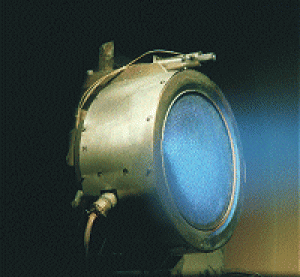Can ion propulsion really lead the way to the outer planets? No one can know for sure, but recent advances in solar-electric propulsion surely make ion methods a prime candidate. Not only has SMART-1 conducted a thorough ion engine shakedown on its lengthy and circuitious route to the Moon, but a variety of new studies are showing the way to more powerful ion thrusters that will eventually lead to the nuclear-electric systems we’ll need for deep space missions.
 Today’s standard ion engine is called NSTAR (it’s a short acronym for a long term: the NASA Solar Electric Propulsion Technology Application Readiness thruster). The agency used one of these on its highly successful Deep Space 1 mission. In tests at the Jet Propulsion Laboratory, an NSTAR thruster was operated for a continuous 30,352 hours. That’s almost five years of operation for an engine whose design life was only 8,000 hours. You can read more about that test in this NASA news release (PDF warning).
Today’s standard ion engine is called NSTAR (it’s a short acronym for a long term: the NASA Solar Electric Propulsion Technology Application Readiness thruster). The agency used one of these on its highly successful Deep Space 1 mission. In tests at the Jet Propulsion Laboratory, an NSTAR thruster was operated for a continuous 30,352 hours. That’s almost five years of operation for an engine whose design life was only 8,000 hours. You can read more about that test in this NASA news release (PDF warning).
Image: This xenon ion engine prototype, photographed through a port of the vacuum chamber where it was being tested at NASA’s Jet Propulsion Laboratory, shows the faint blue glow of charged atoms being emitted from the engine. A similar engine powered the Deep Space 1 spacecraft. Credit: Jet Propulsion Laboratory.
But ion propulsion is a rapidly moving target, with numerous technologies under study at NASA and elsewhere. One effort to focus on is NEXT — the NASA Evolutionary Xenon Thruster — now being developed under the agency’s In-Space Propulsion effort. NEXT holds the promise of doubling current ion thruster power capacities while increasing specific impulse by 32 percent. Moreover, NEXT offers deep-throttling capability to manage changes in input power over the course of a mission. The system, wrote NASA’s Randy Baggett (in an abstract for his talk at the recent AAS meeting in Louisville) “…offers Discovery, New Frontiers, Mars Exploration and outer-planet missions a larger deliverable payload mass and a smaller launch vehicle size.”
As these studies coalesce, we’ll witness the advent of reliable and fuel efficient engines that will leave chemical methods in the dust. The high thrust of a chemical engine can get you into orbit, but it’s the slow and steady burn of an ion thruster that maximizes your chances in the outer Solar System. More on NEXT is available at Glenn Research Center’s Power & Propulsion Office and via MSFC. Also, be aware of Richard Hofer’s Weblog Electric Propulsion, which tracks new developments in the field. A precis of Baggett’s Louisville presentation is available here.


I would like to ask you some questions about the ion engine and all or any answers will be much appreciated.
how much xenon atoms are in our atmosphere?
is it enough to make the satellite launch itself?
how are xenon atoms different than regular atoms?
if you can excite the atom, there must be a way to neutralize it. Is there something that can neutralize the atom and still be easily obtained and renewable?
can atoms be ejected and not neutralized?
can an electrically charged atom harm a person if the two come in contact?
how can electrically charged atoms affect the environment?
Brent, I’ll answer you by backchannel e-mail. Some readers may want to chime in with their thoughts as well.
How much does the ion thruster relate to the Hall Effect Thruster?
Sir, I have several questions, actually. 1. I’ve been reading up on Ion Thrusters.It seems that the newest design which they claim can get us to MARS in just 39 days simply looks like they stacked several together, on top of each other. So, why can’t they continue this add on idea and seriously improve the performance specs that way?
2. My question two comes from an observation of mine. I know the reason for using Xenon gas as a propellant is due to it’s large atom size so, why not use MERCURY. As a liquid, it wouldn’t be that compressible, it IS easily turned to a gas and it too is a largish atom. And, it should also be possible to dope this liquid Mercury with such things as Xenon atoms so we could get an even bigger bang for our buck !
3. Here’s a question that I think will be a real stumper … What can we dope our liquid Mercury with that would make it turn a light violet color when it’s in it’s resting phase ( Liquid State ). This or these ingredient(s) are extremely important. But, I can’t think of anything that could do this and, I really hate the test everything trial method since it takes so darned long and, it’s very costly as well. — JT —